Sometimes you need to get serious. The works of Océane Bruel and Dylan Ray Arnold—both their collaborations and solo efforts—have usually been served with a dash of humor. At Arnold’s solo show in Kunsthalle Turku earlier this year, I was amused by the exhibition that looked like a broken portal into some other world. I marveled at the esoteric, carefully-crafted details and slapstick object games. In turn, Bruel’s practice has been more meditative, while retaining a similar sense of lightness prevalent in the artists’ collaborative efforts. But at Helsinki Art Museum’s—HAM for short—gallery, a new, exceptional depth has been unearthed, one that I haven’t witnessed at this intensity in the duo’s prior works. Their joint exhibition, titled The Slow Business of Going, [sic], lives up to its name: some things are far gone while still reminding us of themselves, and business—well, life—is going slow. In short, it’s 2020 everyone.
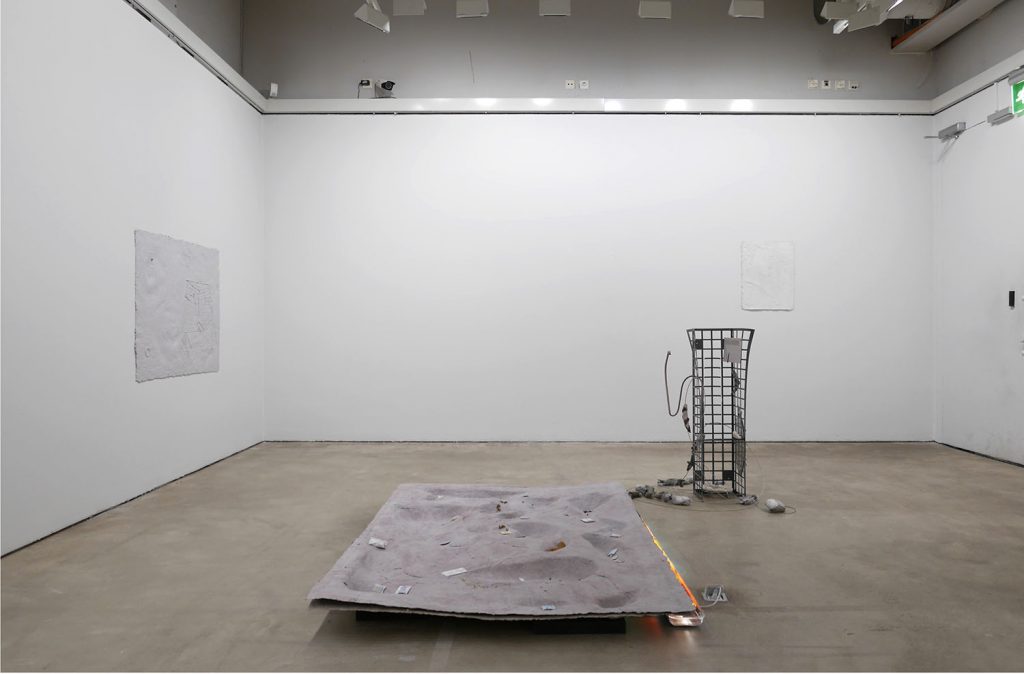
The playfulness is there, but you need to parse it out from the shimmering atmosphere of grief that characterises Arnold and Bruel’s latest project. Visiting the HAM show feels like returning to the site of a trauma you know nothing about, but for its impact. Faint echoes still reverberate.
There’s almost something impressionistic about the overall scene of the exhibition: think of how a Pissarro painting can be more about the mist over the field—the atmosphere—than the vegetation and people habitating the landscape. Likewise, by filling the HAM gallery space with a heady number of artworks that are on the verge of fusing together into one total installation, like some of their previous collaborative pieces did, the artist duo guides you to look at the mood surrounding the works instead of focusing on any single piece. What’s the mood, then? At first sighting, my partner thought of domesticity and loss, and I can’t disagree.
Initially, getting inside the world of the exhibition doesn’t come easily. After spending about three hours with it over a span of five visits, the show becomes my companion and a source of perpetual, private epiphanies. Why was it so hard to feel its pull in the beginning? (After my first drop-in, I called a friend and complained that I didn’t get the show at all.) Perhaps it’s because a slow burner is hard to notice when you’re used to everything served flaming. For some reason, I remembered my immediate reaction—tears, knees trembling, out of breath—from entering Lee Kit’s exhibition You (you) at Venice Biennale in the summer of 2013, and how such responses wouldn’t have been out of place at HAM, either. Like Lee, Arnold and Bruel supercharge unremarkable objects with their inscrutable magic that can turn a plastic bucket (in Lee’s case) or a newspaper tray (Arnold and Bruel’s) into an altar to which you can guide all your desires and traumas. In short, they’re both trading in pop-up churches. Whereas Lee’s domestic non-eventful drama is more of an installation than anything and thus sucks you in immediately, the success of the combined works of The Slow Business of Going, depend on your willingness to soak in the details and disrupted mini-narratives that make up their exhibition. What’s more, the duo deals with the simple yet painful act of passing time—trying to make it pass—so it’s fitting the show asks you to spend a considerable amount of yours. This kind of an exchange can often be found at the core of the kind of art that aims to rekindle something deep inside you. Arnold and Bruel give you your own time back, unraveled and made free from the tapestry of the mundane chaos filling your head.
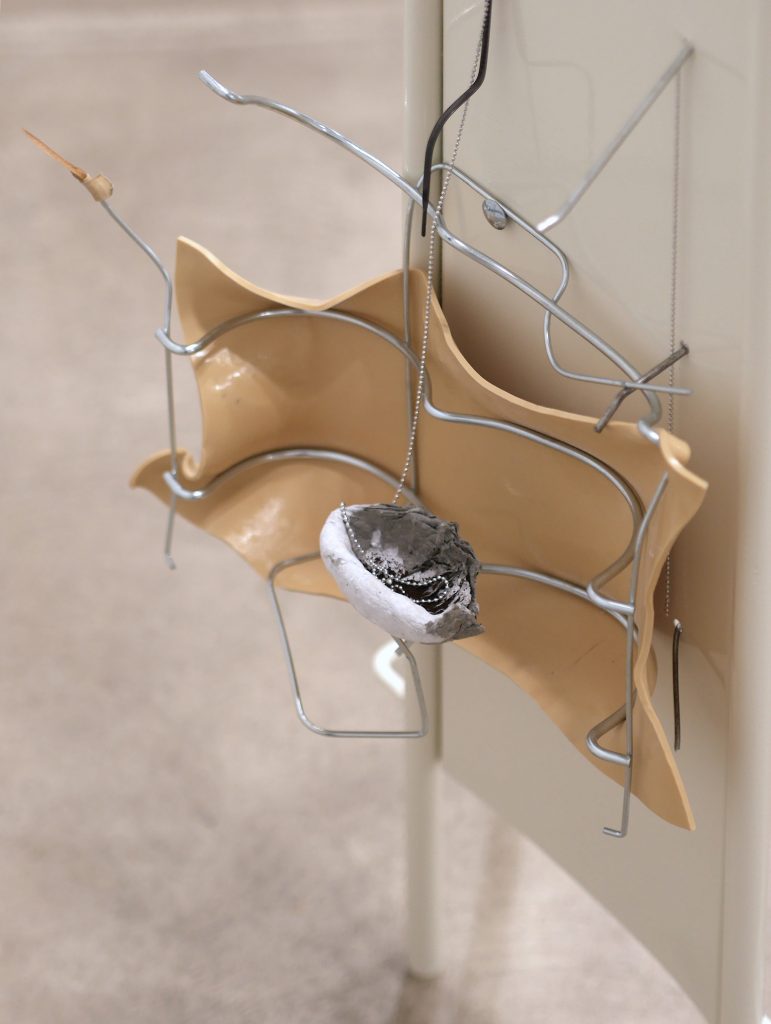
It doesn’t take long to notice a governing principle in the placement of works, as well as in the choice of materials used. Sculptures made mostly of trays create a diagonal line through the first room, whereas certain materials only make an appearance in either one of the rooms. While doing such basic categorisation, you’d be forgiven for judging the show as a mere product of its times: there are unreliable, absurd support structures, an earthly colour palette tilting towards grey, and mundane objects given a new life on the condition they carry discarded junk with them. Put simply, these are the aesthetic tropes of recent times. But this is just the surface, and at any rate shouldn’t be held against Arnold and Bruel. On the contrary, it seems they’ve come to terms with the period in which they happen to be living. In our contemporary art world(s) of broken everything—English, aesthetics, systems, workers—it’s better to use symbols that at least some of us recognise, instead of burning out by trying too hard to stand out. The show’s visual language translates into honesty and soberness, even stoic wisdom, instead of complicity or thirst.
At HAM, the two rooms each sport a different, yet complementary character. Upon entering, you take in the bigger of the two rooms, and either look at the waist-high sculptural objects, or the medium-sized etchings installed on the three walls. Some shows, such as this one, benefit from the amateurish look of the gallery space, with its clunky added walls, backward lighting system and the ugly ventilator pipes zig-zagging overhead. The second room in the back—with an entrance to the offices and an air humidifier that seems to have appeared there sometime during the exhibition—and the unassuming artworks is a match made in perpetually downcast administrative heaven. The space is also where the show takes a more dreamy turn, creating a dialogue with the comparatively clear-cut works in the first room—such as the one depicting the blueprint of a grocery store, like it’s a crime scene. Underneath a large, cast-like square surface ten centimeters in height, you’ll notice two scraps of (I’m guessing) plaster that look like wings. It’s a motif that repeats itself on fabric placed around one of the shelf-like sculptures. It’s also in the second room, with the latter being one of the rare objects with bright, warm hues, save for a fluorescent light stashed under another large cast. Colours, which the artists use sparingly, are of extreme importance here, as are small details such as those semi-hidden wings. The palette is that of a faded memory. The impressionistic feel continues in the sense that The Slow Business of Going, really looks like a landscape study, but not about some lofty summer evening in the countryside, but an unplowed field in your head, made of day-to-day disappointments.
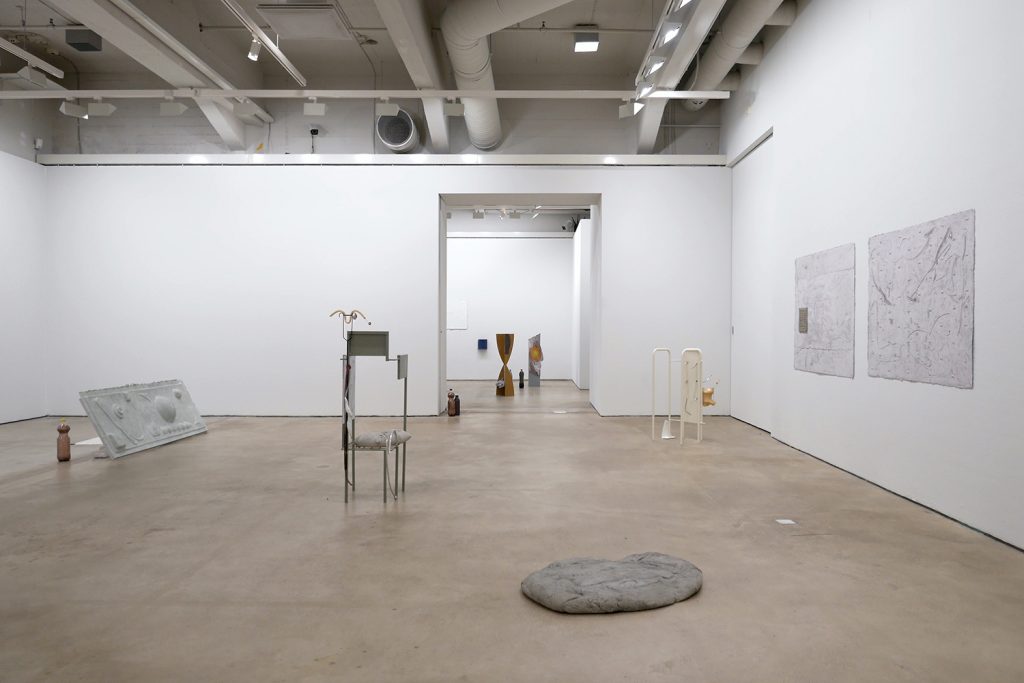
There are two small dark blue trash cans—the half-circle types one can find in buses—in the back room. A fake diamond sits in one of them, on top of what looks like a pile of faux paper trash made of unknown material. Seeing it makes you feel either like all hope is gone, or that there’s hope provided you look for it, depending on one’s mental state. It was the first thing I pointed out to my partner when we went to see the exhibition. Visiting it with someone else can turn you into a child who’s showing off a cave in the forest of which they’ve had the joy of exploring in advance: ‘Look, a shiny thing! See how all the funny paintings with ladders and sperm cells tilt towards pale green and leave you feeling like nothing leads to anything! Does that mean nature is not healing?’
More than anything else, The Slow Business of Going, is an exercise in restraint. Even though there are what could be described as auxiliary, limbic things sort of bleeding out from the sculptures, with small, curious decorative items stuck on their every surface, the artworks and the things they’ve made of are all tightly set in their place. Nothing really bleeds. There are plastic bottles—in their previous lives, they stored soda—scattered across the floor. They’re filled to the brim with dark liquids, as if all the wet parts from this shy world created by the artists have been sucked out, contained, and kept on sight so you’d know what you’re missing. One sculpture, close to the opening in the artificial wall that separates the two rooms, includes a plastic cast of a torso. It faces away from your gaze. Here, I start to cry. The bottles and the torso play the resonant frequencies of my identity like a stranger passing you on the street who sees you. ‘This is how you deal with sexuality and gender,’ I jot down in my notebook. Compared to the infinite number of art exhibitions that act as public relations agencies for a topical topic, this show comes to you from the crevices of real life—more pressure than press release.
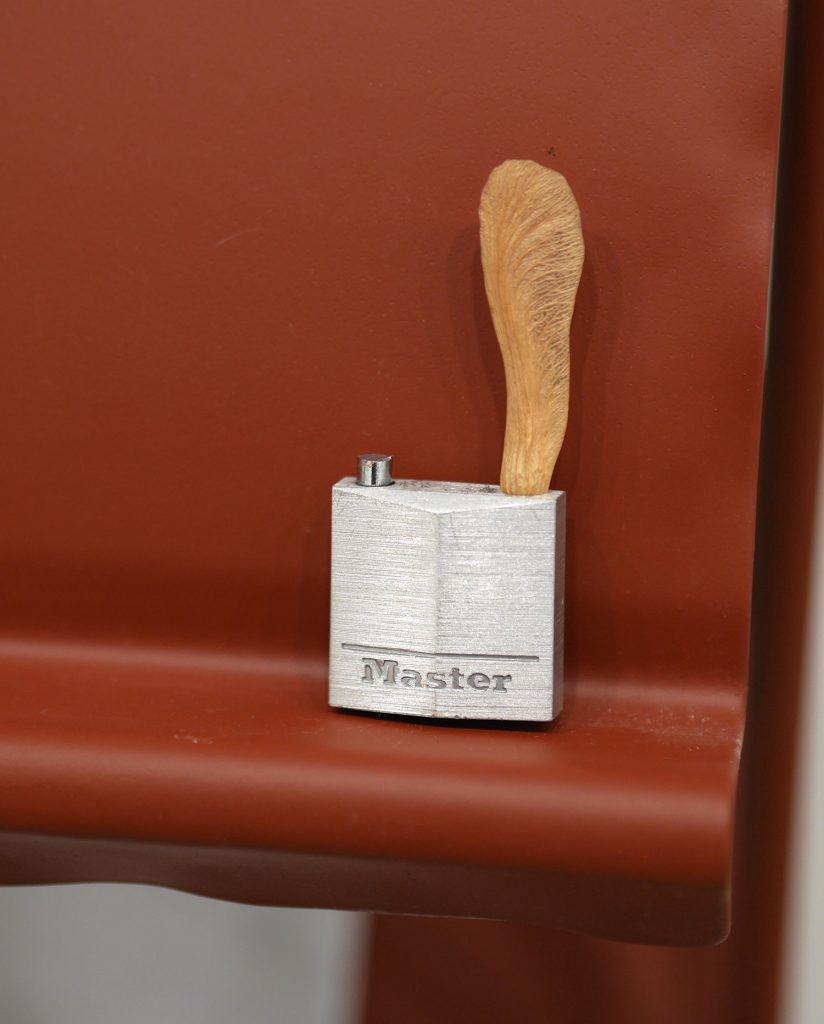
But the pressure is never really being let out. It’s simply managed. Consider the show’s pedantic ordering of items as a solution to the chaos of pain, rather than an aesthetic obsession. The way each artwork somehow succeeds in taking their place in the gallery, while cutting off all communication between each work, reminds me of the experience of time following loss. Days bear no temporal meaning. My father-in-law died on the first day of the year, and it took months before I and my partner reached day two. Although Arnold and Bruel have included small, beautiful items that act as signals of hope into the pockets of their sculptures, it feels like the healing hasn’t begun—can’t see it yet in the horizon. You’ve begun to put things in order, though. You don’t know what it means but you keep doing it. You wonder if organising your books by colour is a sign of spiraling mental health, or the first step toward returning to a semblance of normalcy.
I tried to find the works the artist duo has installed outside as part of the show. They reside somewhere around Baana, the bicycle underpass that runs through central Helsinki. I make my way down there. I look at people bicycling to and from stress. I don’t see the artworks, but I’m not trying that hard. Maybe it’s better this way, for two reasons. First, the pieces that make up The Slow Business of Going, are meant for indoors, insulated. A traditional artist-run space with a window would’ve given their present works a misguided lightness. The many grids and blinds included in the assemblages by Arnold and Bruel point to a lack of fresh air in the gallery, or a kind of claustrophobia. Secondly, the artists have tapped into such a powerful aesthetic that the world outside seems to bend to their vision. While at Baana, I’m looking at a discarded soda can, graffiti that seems like a map written in an alien language, and leaves stuck on drainage grids. The leaves resemble the many winged fruits of maples inserted in the grills in some of the artworks back at the gallery.
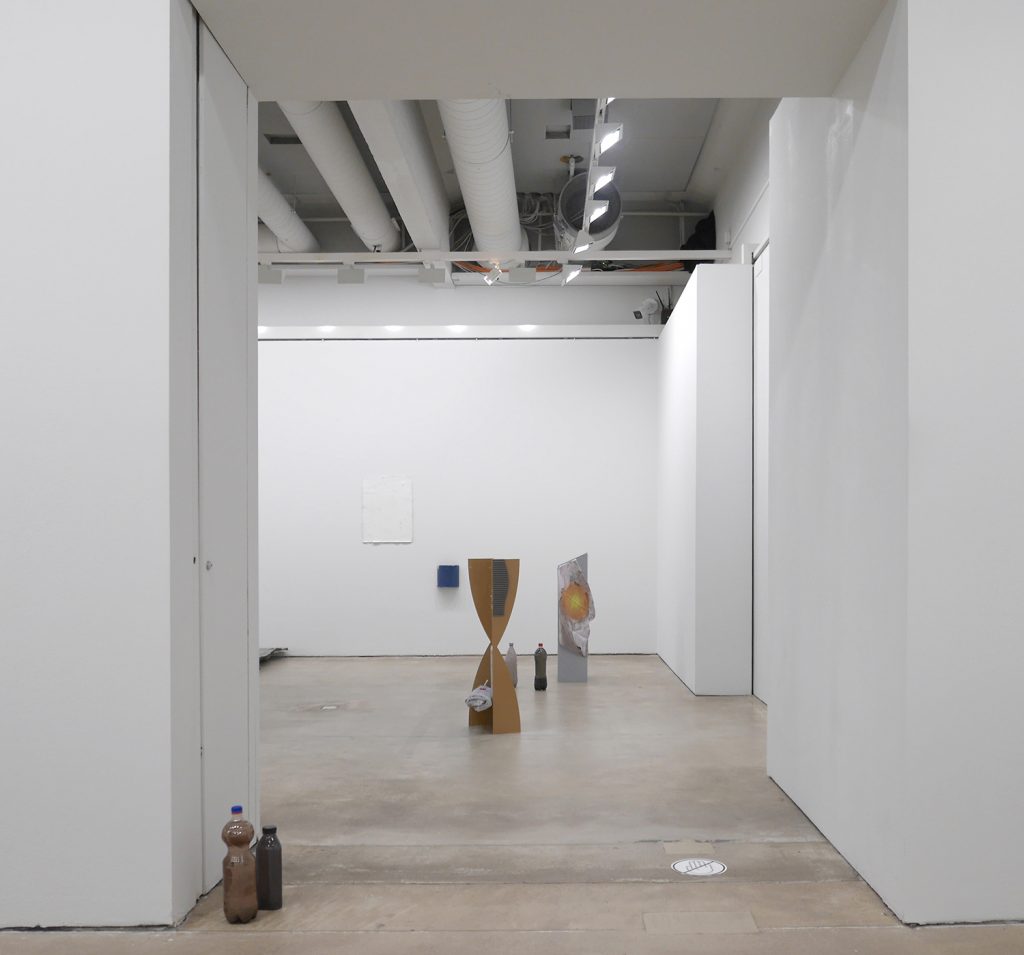
Like the fruits, the leaves look like they’re barely hanging on to their temporary resting spots, but also that barely-hanging-on is quite enough: the inexplicable, unspeakable beauty of quietly making it is a far more magnificent sight to behold than what usually passes for momentous. In making (a) room for us to contemplate our own quiet, bondaged struggles, Arnold and Bruel show you how art can help: by nudging you to take the time you need. And where does this happen? To quote T.S. Eliot, writing on the nature of letters, ‘the fine things come in unexpectedly, neither introduced nor shown out, but between trifle and trifle’.**













